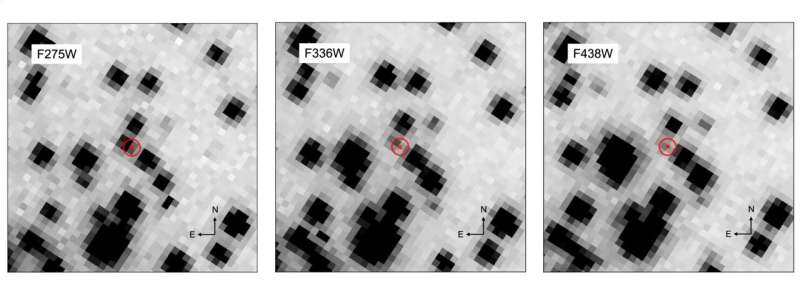March 28, 2023 report
This article has been reviewed according to Science X's editorial process and policies. Editors have highlighted the following attributes while ensuring the content's credibility:
fact-checked
preprint
trusted source
proofread
Young white dwarf orbits millisecond pulsar PSR J1835−3259B, study finds

By analyzing the data from the Hubble Space Telescope (HST), astronomers from the University of Bologna in Italy and elsewhere have found that the millisecond pulsar PSR J1835−3259B has a young white dwarf companion. The finding is reported in a paper published March 20 on the arXiv pre-print server.
Pulsars are highly magnetized, rotating neutron stars emitting a beam of electromagnetic radiation. The most rapidly rotating pulsars, with rotation periods below 30 milliseconds, are known as millisecond pulsars (MSPs). Astronomers assume that they are formed in binary systems when the initially more massive component turns into a neutron star that is then spun up due to accretion of matter from the secondary star.
PSR J1835−3259B has been recently identified as a binary MSP in the Galactic globular cluster NGC 6652, located some 33,000 light years away. It has a rotation period of about 1.83 milliseconds and a companion on a 1.2-day orbit. However, the nature of the orbiting object remains unknown, and previous studies have suggested that it may be a white dwarf.
Therefore, a team of astronomers led by Jianxing Chen decided to inspect PSR J1835−3259B by analyzing the available data from HST. They combed through the high-resolution and deep photometric data acquired with the HST in the near-ultraviolet band, captured by the Wide Field Camera 3 (WFC3).
"Taking advantage of deep photometric archival observations acquired through the Hubble Space Telescope in near-ultraviolet and optical bands, we identified a bright and blue object at a position compatible with that of the radio pulsar," the researchers wrote in the paper.
The color-magnitude diagram (CMD) of the NGC 6652 cluster shows that this blue object is located along the red side of the brightest portion of the white dwarf cooling sequence. Hence, the astronomers concluded that the companion of PSR J1835−3259B is a helium white dwarf—an exhausted core of an evolving star which lost its envelope likely due to the mass transfer onto the neutron star.
The astronomers compared the results with binary evolution models, what revealed that the white dwarf's cooling age is only 200 million years, its mass is about 0.17 solar masses and that its surface temperature is approximately 11,500 K. They assume that the companion object underwent a bloated proto-white dwarf phase that lasted some 1.2 billion years.
The researchers concluded that the progenitor of such a young and low-mass white dwarf had a mass at a level of 0.87 solar masses and developed a helium core with a mass of 0.17 solar masses during the first stages of the evolution along the red giant branch, before the Roche-Lobe detachment. The mass of the neutron star in the PSR J1835−3259B binary is estimated by the authors of the paper to be 1.44 solar masses. They added that the neutron star is seen at an almost edge-on orbit.
More information: J. Chen et al, A young white dwarf orbiting PSR J1835-3259B in the bulge globular cluster NGC 6652, arXiv (2023). DOI: 10.48550/arxiv.2303.11263
Journal information: arXiv
© 2023 Science X Network



















